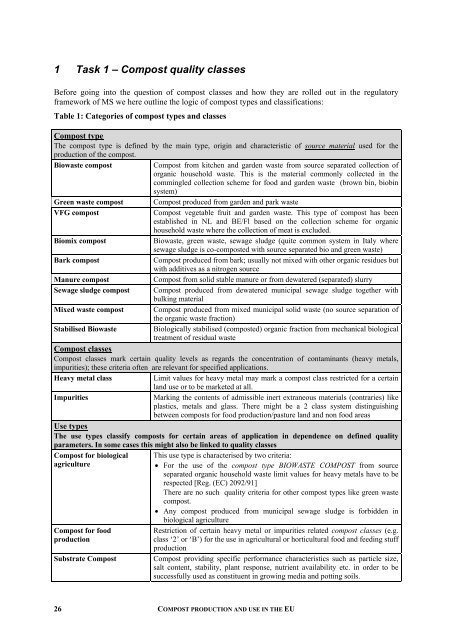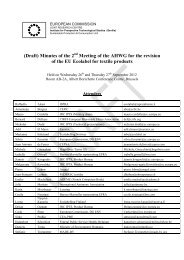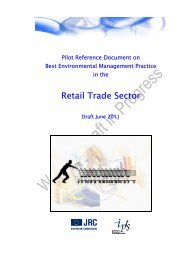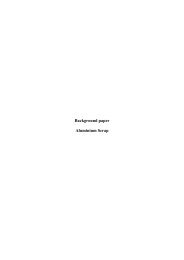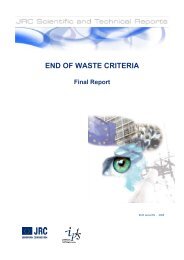final report - JRC IPTS - Sustainable Production and Consumption ...
final report - JRC IPTS - Sustainable Production and Consumption ...
final report - JRC IPTS - Sustainable Production and Consumption ...
Create successful ePaper yourself
Turn your PDF publications into a flip-book with our unique Google optimized e-Paper software.
1 Task 1 – Compost quality classes<br />
Before going into the question of compost classes <strong>and</strong> how they are rolled out in the regulatory<br />
framework of MS we here outline the logic of compost types <strong>and</strong> classifications:<br />
Table 1: Categories of compost types <strong>and</strong> classes<br />
Compost type<br />
The compost type is defined by the main type, origin <strong>and</strong> characteristic of source material used for the<br />
production of the compost.<br />
Biowaste compost Compost from kitchen <strong>and</strong> garden waste from source separated collection of<br />
organic household waste. This is the material commonly collected in the<br />
commingled collection scheme for food <strong>and</strong> garden waste (brown bin, biobin<br />
system)<br />
Green waste compost Compost produced from garden <strong>and</strong> park waste<br />
VFG compost Compost vegetable fruit <strong>and</strong> garden waste. This type of compost has been<br />
established in NL <strong>and</strong> BE/Fl based on the collection scheme for organic<br />
household waste where the collection of meat is excluded.<br />
Biomix compost Biowaste, green waste, sewage sludge (quite common system in Italy where<br />
sewage sludge is co-composted with source separated bio <strong>and</strong> green waste)<br />
Bark compost Compost produced from bark; usually not mixed with other organic residues but<br />
with additives as a nitrogen source<br />
Manure compost Compost from solid stable manure or from dewatered (separated) slurry<br />
Sewage sludge compost Compost produced from dewatered municipal sewage sludge together with<br />
bulking material<br />
Mixed waste compost Compost produced from mixed municipal solid waste (no source separation of<br />
the organic waste fraction)<br />
Stabilised Biowaste Biologically stabilised (composted) organic fraction from mechanical biological<br />
treatment of residual waste<br />
Compost classes<br />
Compost classes mark certain quality levels as regards the concentration of contaminants (heavy metals,<br />
impurities); these criteria often are relevant for specified applications.<br />
Heavy metal class Limit values for heavy metal may mark a compost class restricted for a certain<br />
l<strong>and</strong> use or to be marketed at all.<br />
Impurities Marking the contents of admissible inert extraneous materials (contraries) like<br />
plastics, metals <strong>and</strong> glass. There might be a 2 class system distinguishing<br />
between composts for food production/pasture l<strong>and</strong> <strong>and</strong> non food areas<br />
Use types<br />
The use types classify composts for certain areas of application in dependence on defined quality<br />
parameters. In some cases this might also be linked to quality classes<br />
Compost for biological<br />
agriculture<br />
Compost for food<br />
production<br />
26<br />
This use type is characterised by two criteria:<br />
• For the use of the compost type BIOWASTE COMPOST from source<br />
separated organic household waste limit values for heavy metals have to be<br />
respected [Reg. (EC) 2092/91]<br />
There are no such quality criteria for other compost types like green waste<br />
compost.<br />
• Any compost produced from municipal sewage sludge is forbidden in<br />
biological agriculture<br />
Restriction of certain heavy metal or impurities related compost classes (e.g.<br />
class ‘2’ or ‘B’) for the use in agricultural or horticultural food <strong>and</strong> feeding stuff<br />
production<br />
Substrate Compost Compost providing specific performance characteristics such as particle size,<br />
salt content, stability, plant response, nutrient availability etc. in order to be<br />
successfully used as constituent in growing media <strong>and</strong> potting soils.<br />
COMPOST PRODUCTION AND USE IN THE EU


